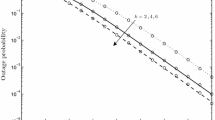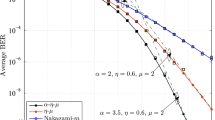Abstract
In this paper, we present a unified framework to analyze the performance of the average bit error probability (BEP) and the outage probability over generalized fading channels. Specifically, we assume that the probability density function (PDF) of the instantaneous signal-to-noise ratio \(\zeta \) is given by the product of: power function, exponential function, and the modified Bessel function of the first kind, i.e., \(f_{\zeta }(\zeta )=\zeta ^{\lambda -1}exp\left( -a\zeta ^{\beta }\right) I_{v}\left( b\zeta ^{\beta }\right) \). Based on this PDF, we obtain a novel closed-form expression for the average BEP over such channels perturbed by an additive white generalized Gaussian noise (AWGGN). Note that other well-known noise types can be deduced from the AWGGN as special cases such as Gaussian noise, Laplacian noise, and impulsive noise. Furthermore, we obtain a novel closed-form expression for the outage probability. As an example of such channels, and without loss of generality, we analyze the performance of the average BEP and the outage probability over the \(\eta \)–\(\mu \) fading channels. Analytical results accompanied with Monte-Carlo simulations are provided to validate our analysis.





Similar content being viewed by others
Explore related subjects
Discover the latest articles, news and stories from top researchers in related subjects.Notes
Note that the BFHF in (15) converges if the following conditions are satisfied [23]: \(\rho _{1}=\sum _{j=1}^{p_{1}}\alpha _{j}+\sum _{j=1}^{p_{2}}\gamma _{j}-\sum _{j=1}^{q_{1}}\beta _{j}-\sum _{j=1}^{q_{2}}\delta _{j}\le 0, \rho _{2}=\sum _{j=1}^{p_{1}}A_{j}+\sum _{j=1}^{p_{2}}E_{j}-\sum _{j=1}^{q_{1}}B_{j}-\sum _{j=1}^{q_{2}}F_{j}\le 0, \Omega _{1}=-\sum _{j=n_{1}+1}^{p_{1}}\alpha _{j}-\sum _{j=1}^{q_{1}}\beta _{j}+\sum _{j=1}^{m_{2}}\delta _{j}-\sum _{j=m_{2}+1}^{p_{2}}\delta _{j}+\sum _{j=1}^{n_{2}}\gamma _{j}-\sum _{n_{2}+1}^{p_{2}}\gamma _{j}>0, \Omega _{2}=-\sum _{j=n_{1}+1}^{p_{1}}A_{j}-\sum _{j=1}^{q_{1}}B_{j}+\) \(\sum _{j=1}^{m_{3}}F_{j}-\sum _{j=m_{3}+1}^{p_{3}}F_{j}+\sum _{j=1}^{n_{3}}E_{j}-\sum _{n_{3}+1}^{p_{3}}E_{j}>0, |\mathrm{arg}~x|<\pi \Omega _{1}/2; \mathrm{and}~|\mathrm{arg}~y|<\pi \Omega _{2}/2\). It is straightforward to show that the parameters of the BFHF in (15) satisfies these sufficient conditions, and therefore the BFHF converges.
References
Kassam, S. A. (1988). Signal detection in non-gaussian noise. Berlin: Springer.
Chapeau-Blondeau, F. (2000). Nonlinear test statistic to improve signal detection in non-Gaussian noise. IEEE Signal Processing Letters, 7(7), 205–207.
Soury, H., Yilmaz, F., & Alouini, M.-S. (2012). Average bit error probability of binary coherent signaling over generalized fading channels subject to additive generalized Gaussian noise. IEEE Communications Letters, 16(6), 785–788.
Soury, H., Yilmaz, F., & Alouini, M. S. (2013). Error rates of \(M\)-PAM and \(M\)-QAM in generalized fading and generalized Gaussian noise environments. IEEE Communications Letters, 17(10), 1932–1935.
Soury, H. & Alouini, M.-S. (2014). On the symbol error rate of \(M\)-ary MPSK over generalized fading channels with additive Laplacian noise. In Proceedings of the IEEE ISIT (pp. 2879–2883).
Hu, B. & Beaulieu, N. C. (2008). On characterizing multiple access interference in TH-UWB systems with impulsive noise model. In Proceedings of the IEEE radio wireless symposium (pp. 879–882).
Fiorina, J. (2006). A simple IR-UWB receiver adapted to multi-user interferences. In Proceedings of the IEEE Globecom (pp. 1–4).
Dhibi, Y., & Kaiser, T. (2006). On the impulsiveness of multiuser interferences in Th-ppm-uwb systems. IEEE Transactions on Signal Processing, 54(7), 2853–2857.
Thompson, M. W., & Chang, H. S. (1994). Coherent detection in Laplace noise. IEEE Transactions on Aerospace and Electronic Systems, 30(2), 452–461.
Li T.H. & Song, K. S. (1990). Estimation of the frequency of sinusoidal signals in Laplace noise. In Proceedings of the IEEE international symposium on information theory (pp. 1786–1790).
Helstrom, C. W. (1989). Detectability of signals in Laplace noise. IEEE Transactions on Aerospace and Electronic Systems, 25(2), 190–196.
Marks, R. J., Wise, G. L., Haldeman, D. G., & Whited, J. L. (1978). Detection in Laplace noise. IEEE Transactions on Aerospace and Electronic Systems, AES–14(6), 866–871.
Simon, M. K., & Alouini, M. (2005). Digital communications over fading channels. New York: Wiley.
Ansari, I.S., Yilmaz, F., Alouini, M.-S. & Kucur, O. (2014). New results on the sum of gamma random variates with application to the performance of wireless communication systems over nakagami-m fading channels. Transactions on Emerging Telecommunications Technologies. doi:10.1002/ett.2912.
Efthymoglou, G., Ermolova, N., & Aalo, V. (2010). Channel capacity and average error rates in generalised-\({K}\) fading channels. IET Communications, 4(11), 1364–1372.
Ermolova, N. Y. & Tirkkonen, O. (2013). Performance analysis of communication systems over generalized \(\alpha \)-\(\lambda \)-\(\eta \)-\(\mu \) fading radio channels. In Proceedings of the 77th IEEE Vehicular Technology VTC (pp. 1–5).
da Costa, D. B., & Yacoub, M. D. (2008). Moment generating functions of generalized fading distributions and applications. IEEE Communications Letters, 12(2), 112–114.
Badarneh, O. S. (2015). Error rate analysis of \(m\)-ary phase shift keying in \(\alpha \)-\(\eta \)-\(\mu \) fading channels subject to additive Laplacian noise. IEEE Communications Letters, 19(7), 1253–1256.
Salahat, E. & Hakam, A. (2014). Novel unified expressions for error rates and ergodic channel capacity analysis over generalized fading subject to AWGGN. In Proceedings of the IEEE GlobeCom (pp. 3976–3982).
Salahat, E. & Saleh, H. (2014). Novel average bit error rate analysis of generalized fading channels subject to additive white generalized Gaussian noise. In Proceedings of the GlobalSIP (pp. 1107–1111).
Papazafeiropoulos, A. K. & Kotsopoulos, S. A. (2009). The \(\alpha \)-\(\lambda \)-\(\mu \)-\(\eta \): A generalized fading distribution In Procedings of the IEEE WCNC (pp. 404–409).
Gradshteyn, I. S., & Ryzhik, I. M. (2007). Table of integrals, series, and products (7th ed.). California: Academic Press.
Mathai, A., Saxena, R., & Haubold, H. J. (2010). The H-function theory applications. New York: Springer.
Chaudhry, M. A., & Zubair, S. M. (2002). On a class of incomplete gamma function with applications. London: Chapman & Hall and CRC.
Prudnikov, A. P., Brychkov, Y. A., & Marichev, O. I. (1990). Integrals, and series: More special functions (3rd ed.). New York: Gordon & Breach Science.
Kilbas, A., & Saigo, M. (2004). H-transforms : Theory and applications (analytical method and special function) (1st ed.). London: CRC Press.
Prudnikov, A. P., Brychkov, Y. A., & Marichev, O. I. (1990). Integrals, and series: More special functions (1st ed.). New York: Gordon & Breach Science.
Yacoub, M. D. (2007). The \(\kappa \)-\(\mu \) distribution and the \(\eta \)-\(\mu \) distribution. IEEE Antennas and Propagation Magazine, 49(1), 68–81.
Morales-Jiménez, D., & Paris, J. F. (2010). Outage probability analysis for \(\eta \)-\(\mu \) fading channels. IEEE Communication Letters, 14(6), 521–523.
Author information
Authors and Affiliations
Corresponding author
Rights and permissions
About this article
Cite this article
Badarneh, O.S., Aldalgamouni, T. & Almehmadi, F.S. A unified framework for performance evaluation over generalized fading channels. Telecommun Syst 64, 669–678 (2017). https://doi.org/10.1007/s11235-016-0199-6
Published:
Issue Date:
DOI: https://doi.org/10.1007/s11235-016-0199-6




